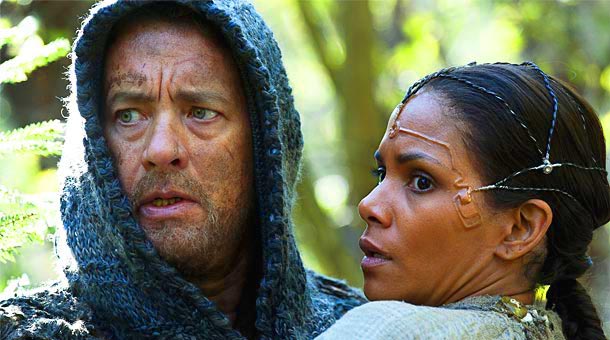
All the stories brilliantly peak at the same time, making for one epic climax, once you first let all the stories develop independently.

All the stories brilliantly peak at the same time, making for one epic climax, once you first let all the stories develop independently.
Cloud Atlas is a big film by all definitions; it contains an inordinate amount of characters spread out across hundreds of years, making the shear scope of the production epic. Not to mention the estimated budget of 100 million dollars (though it was independently financed outside the studio). To pull off such an ambitious feat, the film split the directorial duties among a trio of film visionaries, Tom Tykwer (Run Lola Run) and the Wachowskis siblings (Andy and Lana, The Matrix trilogy). However, Cloud Atlas’ biggest accomplishment may also be its biggest flaw; the overloaded plotlines are never boring, but at times they can be too much to follow.
When characters are first introduced in the opening sequence, one of them in particular seems to be speaking directly to the audience. That character is an older man (Jim Broadbent) on a typewriter who describes his time spent as an editor has made him dislike gimmicky storytelling involving flashbacks and flashforwards. But he goes on to say that if you have some patience you can then see that there is a method to its madness. That whole scene only lasts a few moments before going on to the next introduction, but it almost seemed to be begging the viewer to embrace what is about to unfold.
The plea to be patient between the back and forth storytelling proved to be necessary as Cloud Atlas contains six different time periods, each with their own plotline and characters. While everything happens in linear fashion in each time period, the film does jump between the six different time periods at will. Even though there are six different storylines, similar themes and characters are shared across them all, making everything connected to each other. The film brilliantly shifts from one period to another by using cleaver scene transitions. One example of this is when the thundering sound of horses galloping from one era leads into the next with a similar sound of a train racing on its tracks.

Cloud Atlas spans across several hundreds of years, ranging from the 1800s to the 2300s and several years in between as well. In the earliest setting of 1850, Adam (Jim Sturgess) is a wealthy pro-slavery American Lawyer who is poisoned by a corrupt doctor (Tom Hanks) for his fortune. He eventually switches his stance on slavery when a slave saves his life. In 1931, an upcoming composer (Ben Whisaw) works closely under one of the best known composers of the time (Jim Broadbent), but fears that his original masterpiece will be wrongfully claimed by his famous superior. Set in the 1970s, the daughter of a famous reporter, Luisa Rey (Halle Berry), is an investigative journalist who is looking to prove herself by uncovering a corrupt business leader (Hugh Grant). In the year 2012, a publisher named Timothy (Jim Broadbent) finally makes it big when an author’s (Tom Hanks) book flies off shelves after he murders a book critic. A few men go after Timothy for his money, which he does not have, forcing him to ask his deceitful brother for a loan who instead offers him a safe house. But Timothy’s finds himself captive in a nursing home instead. A hundred years in the future, a slave restaurant waitress manages to escape from her captivity to start a revolution. The last storyline is set far into the future, a member of an advanced civilization (Halle Berry) teams up with an island tribesman (Tom Hanks) to help solve each other’s dilemmas.
The common theme that stiches the six tales together is the desire of freedom. No matter what age the character lives in, there is someone there that wants to restrict the amount of power and freedom you possess. During each stretch of time, characters are morally challenged to stand up for what they believe in.
Because most cast in the film got to play both the hero and the villain, Cloud Atlas must have been an actor’s fantasy. Take the numerous roles that Tom Hanks had in the film for an example. He wonderfully portrayed the crooked doctor back in the 1800s but got a chance to redeem himself later as a good scientist in a different time period. Hanks, like other fellow cast members, is sometimes unrecognizable at first because of the amazing makeup job that serves as a disguise to their age, ethnicity and even gender.
Cloud Atlas is an entertaining yet dense film that contains many wonderfully told stories which link together seamlessly. All the stories brilliantly peak at the same time, making for one epic climax, once you first let all the stories develop independently. It is easy to get caught up in the web of trying to make all the connections between the characters – making a repeat viewing seemingly necessary. However, the major themes and messages are apparent enough in the film without the requirement of multiple viewings; but you must accept that some of the finer details will likely get lost in the shuffle.